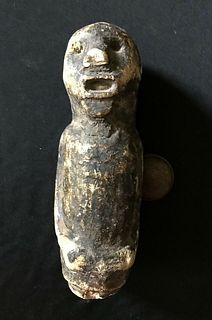Veracruz Stone Anthropomorphic Head Hacha
Lot 68
About Seller
Artemis Fine Arts
686 S Taylor Ave, Ste 106
Louisville, CO 80027
United States
Selling antiquities, ancient and ethnographic art online since 1993, Artemis Gallery specializes in Classical Antiquities (Egyptian, Greek, Roman, Near Eastern), Asian, Pre-Columbian, African / Tribal / Oceanographic art. Our extensive inventory includes pottery, stone, metal, wood, glass and textil...Read more
Estimate:
$1,500 - $2,000
Absentee vs Live bid
Two ways to bid:
- Leave a max absentee bid and the platform will bid on your behalf up to your maximum bid during the live auction.
- Bid live during the auction and your bids will be submitted real-time to the auctioneer.
Bid Increments
| Price | Bid Increment |
|---|---|
| $0 | $25 |
| $300 | $50 |
| $1,000 | $100 |
| $2,000 | $250 |
| $5,000 | $500 |
| $10,000 | $1,000 |
| $20,000 | $2,500 |
| $50,000 | $5,000 |
| $100,000 | $10,000 |
| $200,000 | $20,000 |
About Auction
By Artemis Fine Arts
Jan 7, 2021
Set Reminder
2021-01-07 10:00:00
2021-01-07 10:00:00
America/New_York
Bidsquare
Bidsquare : Ancient / Ethnographic Art Through The Ages
https://www.bidsquare.com/auctions/artemis-gallery/ancient-ethnographic-art-through-the-ages-6258
Ancient art from Egypt, Greece, Italy and the Near East, as well as Asian, Fossils, Pre-Columbian, Native American, African / Tribal / Oceanic, Fine art, and much more! All categories, all price ranges... all legally acquired and guaranteed to be as described or your money back. Artemis Fine Arts info@artemisfinearts.com
Ancient art from Egypt, Greece, Italy and the Near East, as well as Asian, Fossils, Pre-Columbian, Native American, African / Tribal / Oceanic, Fine art, and much more! All categories, all price ranges... all legally acquired and guaranteed to be as described or your money back. Artemis Fine Arts info@artemisfinearts.com
- Lot Description
Pre-Columbian, Gulf Coast Mexico, Veracruz (Vera Cruz), ca. 5th to 7th century CE. A carved-stone hacha in the form of a lifelike anthropomorphic head. A pair of massive ovoid eyes dominates the lively visage, with both eyes slanting inward and nearly touching at the shallow nasal bridge. Presenting an open mouth so wide that it appears fish-like, the unique head features a bulbous nose and a crest that extends from his forehead and curves backwards. Enveloped in natural hues of warm tan and cool grey, this animated visage serves as a wonderful example of Veracruz culture! Size: 4.875" W x 8.625" H (12.4 cm x 21.9 cm)
Hachas were associated with the ritual Mesoamerican ball game, though examples like this were not actually part of the player's equipment. Instead these were worn during ritualistic ceremonies related to the game. The name stems from the fact that they were believed to be axe-heads; hence the term hacha (Spanish for axe). Based on ceramic figures and imagery on stone carvings, some authors have proposed that hachas were meant to be attached to yugos (yokes). Others suggest that some of the hachas could have served as ballcourt markers.
Provenance: ex-Saint Petersburg, Florida, USA collection; ex-Arthur and Lillian Weiss collection, New England, USA, acquired in 1970s
All items legal to buy/sell under U.S. Statute covering cultural patrimony Code 2600, CHAPTER 14, and are guaranteed to be as described or your money back.
A Certificate of Authenticity will accompany all winning bids.
We ship worldwide and handle all shipping in-house for your convenience.
#161045Minor chip to nose. Expected nicks/chips and scratches, commensurate with age. Otherwise, intact and excellent with light earthen deposits in some recessed areas.Condition
- Shipping Info
-
All shipping is handled in-house for your convenience. Your invoice from Artemis Gallery will include shipping calculation instructions. If in doubt, please inquire BEFORE bidding for estimated shipping costs for individual items.
-
- Buyer's Premium



 EUR
EUR CAD
CAD AUD
AUD GBP
GBP MXN
MXN HKD
HKD CNY
CNY MYR
MYR SEK
SEK SGD
SGD CHF
CHF THB
THB














